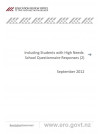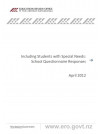All children deserve the right to an education including those with special education needs. Through its Success for All policy, the Government expects all schools to demonstrate inclusive practice for children with special education needs by the end of 2014. This report presents the findings of a questionnaire where schools assess their own provisions for students with special education needs. It follows on from a similar report produced in early 2012.
Key Results
Results from first round
A majority of schools (88 percent) reported having mostly inclusive practices, 12 percent said they had some inclusive practices, and one school said they had few inclusive practices. Some schools said they integrated students with special needs as much as possible, some provided in-class support so that students could be mainstreamed, and some withdrew students for targeted support.
Most schools (81 percent) had a special educational needs coordinator (SENCO). A majority of these SENCOs have had extensive teaching experience with many having special education qualifications or experience.
Almost all schools had accessed some form of professional and learning development or support to help staff include students with special needs. Two-thirds of schools had undertaken special property projects to cater for students with physical disabilities, such as ramps, bathrooms and sound systems.
Schools used a wide range of approaches and programmes to support the learning and inclusion of students with special needs. Systems included:
- clear roles and responsibilities for SENCOs, teachers and teacher aides
- processes to identify the specific needs of students
- prioritising students with the greatest needs
- providing professional learning and development
- staff sharing effective strategies
- IEPs
- transitions processes
- reviewing the effectiveness of programmes to support students with special needs.
A majority of schools provided literacy programmes, and smaller numbers provided programmes to support students numeracy, communication, physical and behavioural needs.
The main challenges schools identified were funding, access to specialist advice and support, students with behavioural needs or high needs, and employing appropriate staff.
When asked about outcomes for students, most schools did not report on the actual gains made by students. Instead, most schools reported general progress, improved attitudes, or described the contribution they had made to the inclusion of students with special needs.
Most schools reported that they gave the Board self-review data about the achievement and inclusion of students with special needs. However, the comprehensiveness of the information varied. Reports to the Board tended to list the types of special needs identified and describe the school’s actions in areas such as staffing, special programmes, resourcing, property and access to specialists. Only 15 percent of schools provided their Boards with any achievement information regarding students with special needs. The lack of achievement information limits a Board’s ability to understand how effectively the school is including students with special needs.
The lack of specific information about the academic outcomes for students also suggests that schools’ ratings of themselves as inclusive are not well supported by evidence that these students have actually been achieving their potential at school
Results from second round
Two hundred and fifty-four schools reviewed by ERO during Terms 3 and 4, 2011, completed a questionnaire about providing for students with special education needs. It should be noted that schools rated their own performance and provided information they considered relevant. Some schools interpreted special needs very broadly and, in some cases, information supplied did not support their rating of how inclusive they are.
Eighty-eight percent of these schools rated themselves as having mostly inclusive practices, 10 percent as having some inclusive practices and one percent (three schools) said they had few inclusive practices.
Most schools expressed positive attitudes to inclusion and identified a variety of ways they provided for students with various special education needs.
- Most schools had policies to address the inclusion of students with disabilities or special education needs.
- Eighty percent of schools had a special education needs coordinator.
- Almost all schools had accessed some form of professional learning and development or support to help staff include students with special needs.
- Schools had developed various approaches and systems to support the learning and inclusion of these students.
- Schools used a wide range of programmes to provide for students with special needs, most often for their literacy and numeracy needs.
- Two-thirds of schools had undertaken special property projects to cater for students with physical disabilities.
- The main challenges schools identified were funding, access to specialist advice and support, employing appropriate staff, and catering for students with challenging behaviours or high needs.
These responses are very similar to those from schools reviewed in Terms 1 and 2, 2011.
When asked about outcomes for students resulting from their systems and programmes, most schools commented in general terms that students had made progress or achieved their learning goals. Some schools reported specific information on aspects of literacy such as raised reading ages, and schools also reported improvements in speech, numeracy/mathematics, social skills and behaviour. Some schools noted that students were more confident, more independent, more engaged, and had developed a sense of belonging to the school.
Most schools said they reported self-review data to the board about the achievement and inclusion of students with special needs. However, analysis of reports provided by 51 schools found variation in terms of the nature and amount of information provided. Most reports contained very little information about the achievement of students with high needs, and did not contain sufficient information for boards of trustees to obtain a comprehensive picture of the impact of the school’s provision on student learning.
Overall, schools expressed positive attitudes towards including students with special needs, and described many ways they included these students in all aspects of school life. However, schools provided less information about how well they promoted students’ learning and academic achievement.
Schools should be gathering and using more robust achievement information to:
- review the effectiveness of their programmes for learners with special needs
- identify which of their strategies are the most effective and promote these among staff to support students to make better progress
- identify needs for professional learning and development.


